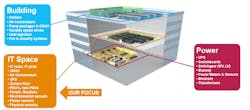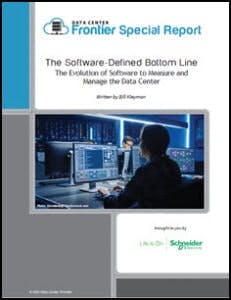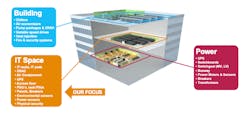DCIM Tools and Partnering to Impact the Software-Defined Bottom Line
This week, we conclude our article series on the evolution of software to measure and manage the data center. In our last article looked at some of the key DCIM attributes. This week, we’ll look at how modern DCIM tools are already making an impact in the data center and hyperscale space by diving into a real-world use-case.
Get the full report
For those who own and operate a portfolio of data centers and/or edge sites (distributed, often unstaffed, small IT sites at the edges of the network), data center infrastructure management (DCIM) software tools are imperative.
Modern DCIM designs also act as security tools to ensure you have a safe and resilient environment. Given that DCIM systems are made up of software apps, servers, gateways, and critical infrastructure devices, all interconnected over mobile and IT networks, it is essential to ensure both the vendor and end-user continuously follow cybersecurity best practices. Next-generation DCIM should simplify this for the end-user by automating the detection and reporting of DCIM gateway and device vulnerabilities. Some DCIM solutions do this using a threat assessment tool. Users are notified if device configurations (e.g., set to use SSH or Telnet) put the device at risk of attack. Devices with outdated firmware are also identified. This greatly simplifies management and automates a critical function of the DCIM system.
Let’s pause here and look at a modern DCIM solution that aims to revolutionize how we manage our most critical infrastructures.
DCIM: Innovating at Every level
EcoStruxure is Schneider Electric’s open, interoperable, IoT-enabled architecture and platform. (See graphic above.) This data center management solution delivers enhanced value around safety, reliability, efficiency, sustainability, and connectivity.
To help evolve the future of data center management, one customer went above and beyond in how they manage their hyperscale ecosystem.
Digital Realty Leverages EcoStruxure Platform
As Digital Realty continues to increase its footprint, everything from system architecture to end-user reporting must be consistent across all sites.
“Over the last year, we took the effort to standardize our global platform to make sure that we can provide consistent monitoring and measuring, but the same look and feel on a global basis.” — Digital Realty
Employing non-standard solutions from site to site leads to operational inefficiencies and inflated costs. With such a diverse portfolio of customers, standardizing operations globally is a must, and even with their current reach, it’s a tall order.
They currently provide colocation data center services to a diverse base of US and international companies in financial services, cloud and information technology, manufacturing, energy, gaming, life sciences, and consumer products. Its 170 data centers serve more than 2,300 customers in 33 metro markets across four continents. They are poised for quick expansion across Europe and Asia-Pacific, and building a consistent infrastructure will be the key to success. That’s where Schneider Electric and EcoStruxure come in.
A single pane of glass
As Digital Realty and Schneider Electric worked together to develop standard solutions and configurations of delivered systems, a big concern was keeping installations standard. Different teams in different world regions will provide the systems, and the installation must support a globally aligned design and configuration.
“To achieve global consistency, we need a partner that can provide products on a global level.” — Digital Realty
Digital Realty uses Schneider’s EcoStruxure platform for various installation products, and the advantage EcoStruxure offers is the ability to integrate all the moving parts into one large solution. By combining EcoStruxure Building Operation and EcoStruxure Power Monitoring Expert, Digital Realty is leveraging the specialized and powerful tools within each platform for a more unified and efficient approach to monitoring and controlling the facilities. EcoStruxure meets the challenge by offering a fully integrated building management and power monitoring system accessible through a single pane of glass.
The solution
Digital Realty and Schneider worked together to develop standard solutions and configurations to ensure consistency for both existing and new customers. By combining EcoStruxure Building Operation and EcoStruxure Power Monitoring Expert, Digital Realty is leveraging the specialized and powerful tools within each platform for a more unified and efficient approach to monitoring and controlling the facilities. It’s all accessible through a single pane of glass. Digital Realty leverages Schneider Electric’s comprehensive portfolio of infrastructure solutions to support its growing global facility base, including the HyperPod integrated rack systems. With HyperPod, Digital Realty has the flexibility to scale to fit customers’ varied configurations with reduced time for installation and faster deployment.
Results
Site operators now have the right tools to run their data centers across the globe efficiently, and Digital Realty has improved operational visibility, enhanced reporting, and optimized facility control. Through the partnership with Schneider Electric, Digital Realty has all the tools they need to execute its future vision successfully.
Furthermore, Digital Realty experienced the following benefits:
- Nearly $1M in annual savings by leveraging a software-defined bottom-line approach to data center management.
- Vastly improved operation visibility into primary sites, remote sites, and critical customer infrastructure.
- End-user reporting became consistent across all sites. Further, Digital Reality was capable of lowering their GHG emissions and improving their ESG posture.
Partnering with Schneider has made it easier for Digital Realty to provide site operators with the right tools to efficiently run their data centers while maintaining the level of resiliency of today’s colocation market demands. Digital Realty has increased access to information, higher productivity, and optimized facility control with EcoStruxure— all through a single pane of glass.
“The future of colocation is limitless; what you can imagine will become a reality.” — Digital Realty, Global Engineering and Design Team
Through the partnership with Schneider Electric, Digital Realty has a clear vision of the future and the tools to get there. As a final point, let’s wrap up the conversation on what you can expect from digital infrastructure and how you can get started in leveraging next-generation data center management solutions.
Download the entire paper, “The Software Defined Bottom Line,” courtesy of Schneider Electric, for exclusive content including additional customer spotlights and discussion of the future of DCIM .
About the Author





